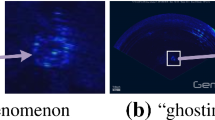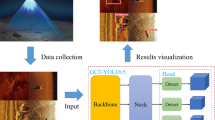Abstract
Current methods for edge contour feature extraction for Unmanned Underwater Vehicle (UUV) side-scan sonar images have yet to solve the problems of low accuracy, discontinuous edges, and loss of detail. This paper proposes a new feature extraction method for UUV side-scan sonar images. By adding a batch normalization layer, the skip structure of the fully convolutional network (FCN) is improved, the redistribution of parameters in the skip structure is realized, and the training of the network is more sufficient. And we design a positive sample weighted loss function (WPSL) to improve the problem that the performance of the classification algorithm is degraded due to the imbalance of sample distribution in the data set. In this paper, an initial dataset is expanded by turning, rotating, and adding noise. An improved feature extraction network is then constructed, and the training of the improved FCN is completed by using a mini-batch gradient descent method, thus realizing accurate extraction of edge contour features of seabed topography. The experimental results show that the proposed method is more suitable to reject speckle noise than the traditional Canny and Fuzzy C-Means algorithms. Compared with current deep learning methods, the proposed method improves the ability to fuse detailed information and make discontinuous edges continuous. The mean intersection over union (IU) reaches 83.05%, which is 5.48% higher than the 77.57% before improvement.














Similar content being viewed by others
References
Bell JM, Petillot Y, Reed S (2001) Unsupervised mine detection and analysis in side-scan sonar: a comparison of markov random fields and statistical snakes. P Natl Acad Sci USA 100(13):8002–8006
Ding X, He Q (2017) Energy-fluctuated multiscale feature learning with deep convnet for intelligent spindle bearing fault diagnosis. IEEE Trans Instrum Meas 66(8):1926–1935
Dzieciuch I, Gebhardt D, Barngrover C, Parikh K (2016) Non-linear convolutional neural network for automatic detection of mine-like objects in sonar imagery. In: International Conference on Applications in Nonlinear Dynamics, pp. 309–314
Flemming BW (2015) Side-scan sonar: a practical guide. Int Hydrog Rev 53(1):65–92
Hellequin L, Boucher JM, Lurton X (2003) Processing of high-frequency multibeam echo sounder data for seafloor characterization. IEEE J Oceanic Eng 28(1):78–89
Hong S, Chunhui Z, Zhengyan S (2010) Spectral clustering for sonar image segmentation using morphological wavelet and gray level transformation. In: International Conference on Computer Science & Education, pp. 1760–1764
Ioffe S, Szegedy C (2015) Batch normalization: accelerating deep network training by reducing internal covariate shift. International Conference on Machine Learning, pp. 448–456
Jia Y, Shelhamer E, Donahue J, et al (2014) Caffe: convolutional architecture for fast feature embedding. International Conference on Multimedia, pp. 675–678
Jiao S, Zhao C, Xin Y (2018) Research on convolutional neural network model for sonar image segmentation. MATEC Web of Conferences 220, 10004
Kim J, Cho H, Pyo J, Kim B, Yu SC (2016) The convolution neural network based agent vehicle detection using forward-looking sonar image. Oceans Conference
Lianantonakis M, Petillot YR (2005) Side-scan sonar segmentation using active contours and level set methods. Oceans Conference, pp. 719–724
Liangchieh C, Papandreou G, Kokkinos I, Murphy K, Yuille A (2014) Semantic image segmentation with deep convolutional nets and fully connected CRFs. Computer ENCE 4:357–361
Long J, Shelhamer E, Darrell T (2017) Fully convolutional networks for semantic segmentation. IEEE Trans Pattern Anal Mach Intell 39(4):640–651
Mignotte M (2000) Hybrid genetic optimization and statistical model-based approach for the classification of shadow shapes in sonar imagery. IEEE Trans Pattern Anal Mach Intell 22(2):129–141
Mignotte M, Collet C, Pérez P, Bouthemy P (1999) Three-class markovian segmentation of high-resolution sonar images. Computer Vis Image Und 76(3):191–204
Mignotte M, Collet C, Perez P, Bouthemy P (2000) Sonar image segmentation using an unsupervised hierarchical MRF model. IEEE Trans Image Process 9(7):1216–1231
Milan S, Roger B, Vaclav H (1993) Image processing, analysis, and machine vision. Chapman & Hall Computing, xix, 555
Reed S, Petillot Y, Bell J (2003) An automatic approach to the detection and extraction of mine features in side scan sonar. IEEE J Ocean Eng 28(1):90–105
Santurkar S, Tsipras D, Ilyas A, Madry A (2018) How does batch normalization help optimization? 32nd Conference on Neural Information Processing Systems, Canada
Trucco A, Garofalo M, Repetto S et al (2009) Processing and analysis of underwater acoustic images generated by mechanically scanned sonar systems. IEEE Trans Instrum Meas 58(7):2061–2071
Valdenegro-Toro M (2017a) Best Practices in Convolutional Networks for Forward-Looking Sonar Image Recognition. Oceans Conference
Valdenegro-Toro M (2017b) Real-time convolutional networks for sonar image classification in low-power embedded systems. Conference on Decision and Control
Wang H, Li S, Song L et al (2019) An enhanced intelligent diagnosis method based on multi-sensor image fusion via improved deep learning network. IEEE Trans Instrum Meas 69(6):2648–2657
Wang X, Hao W, Li Q (2017) An adaptive cultural algorithm with improved quantum-behaved particle swarm optimization for sonar image detection. Sci Rep 7(1):17733
Wang X, Wang H, Ye X, Zhao L, Wang K (2008) A novel segmentation algorithm for side-scan sonar imagery with multi-object. IEEE International Conference on Robotics and Biomimetics
Wei X, Li W, Zhang M et al (2019) Medical hyperspectral image classification based on end-to-end fusion deep neural network. IEEE Trans Instrum Meas 68(11):1–12
Williams DP (2017a) Demystifying deep convolutional neural networks for sonar image classification. Computer Science, Corpus ID: 30407822
Williams, DP (2017b) Underwater target classification in synthetic aperture sonar imagery using deep convolutional neural networks. International Conference on Pattern Recognition
Yan, S et al (2017) Side scan Sonar Segmentation Using Deep Convolutional Neural Network. Oceans Conference
Yegireddi S, Thomas N (2014) Segmentation and classification of shallow subbottom acoustic data, using image processing and neural networks. Mar Geophys Res 35(2):149–156
Zhao, Hengshuang, et al (2017) Pyramid scene parsing network. Proceedings of the IEEE conference on computer vision and pattern recognition
Zhao J, Wang X, Zhang H, Hu J, Jian X (2016) Side scan sonar image segmentation based on neutrosophic set and quantum-behaved particle swarm optimization algorithm. Mar Geophys Res 37(3):229–241
Zhu P, Isaacs J, Fu B, Ferrari S (2017) Deep learning feature extraction for target recognition and classification in underwater sonar images. Conference on Decision and Control
Acknowledgements
This work was supported in part by the National Natural Science Foundation of China [No. 61633008]. Thanks to the open resources on the Internet for deep learning, such as the mature Caffe framework and Python tools.
Author information
Authors and Affiliations
Corresponding author
Additional information
Publisher's Note
Springer Nature remains neutral with regard to jurisdictional claims in published maps and institutional affiliations.
Rights and permissions
About this article
Cite this article
Wang, H., Gao, N., Xiao, Y. et al. Image feature extraction based on improved FCN for UUV side-scan sonar. Mar Geophys Res 41, 18 (2020). https://doi.org/10.1007/s11001-020-09417-7
Received:
Accepted:
Published:
DOI: https://doi.org/10.1007/s11001-020-09417-7




